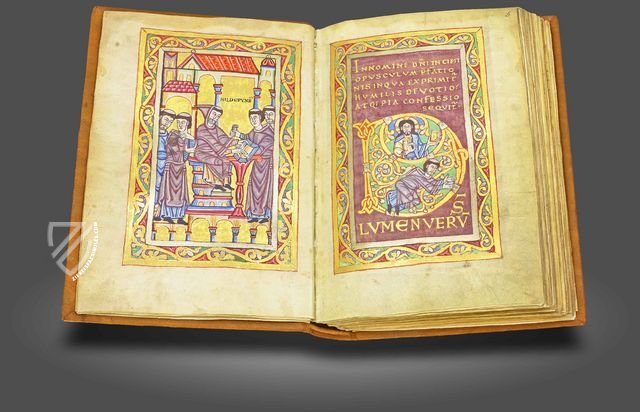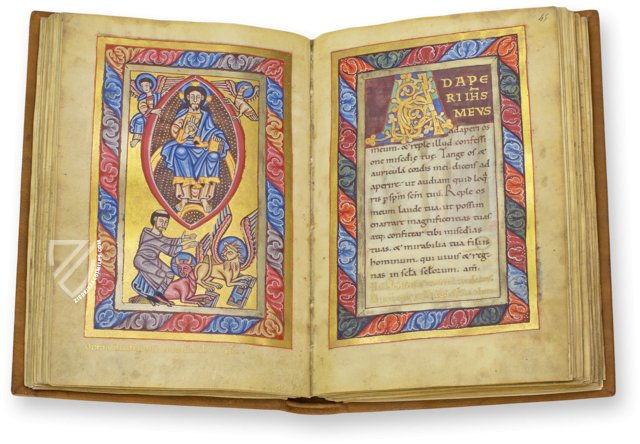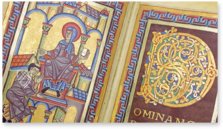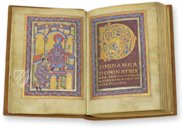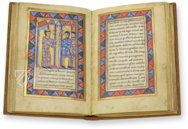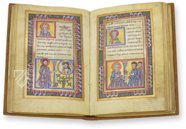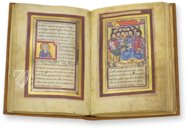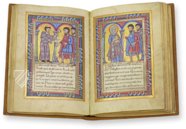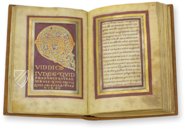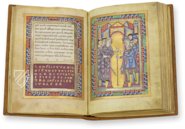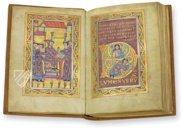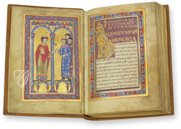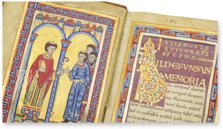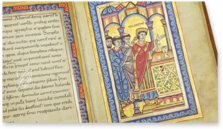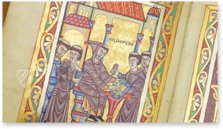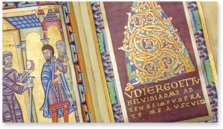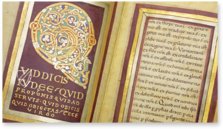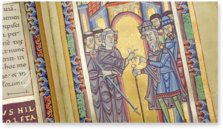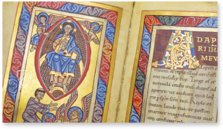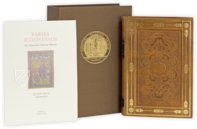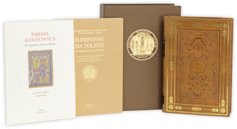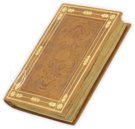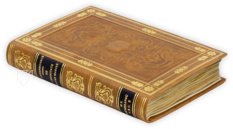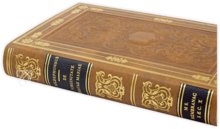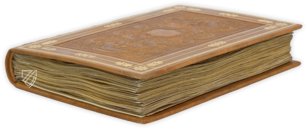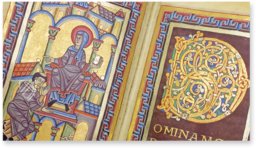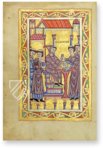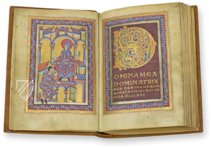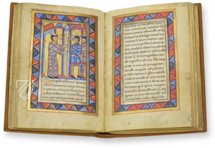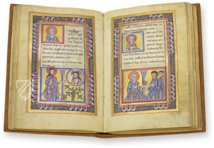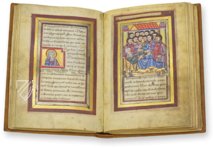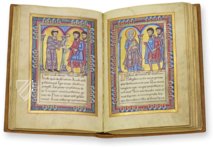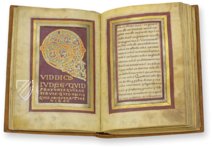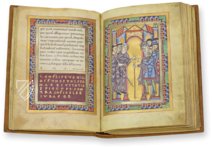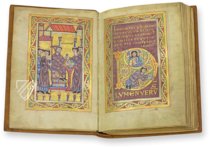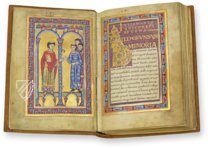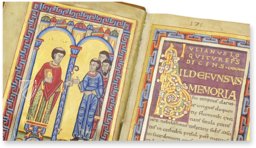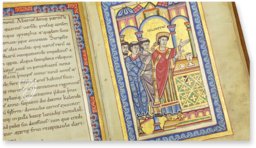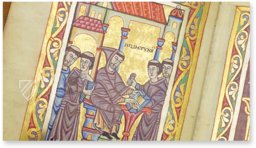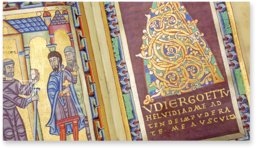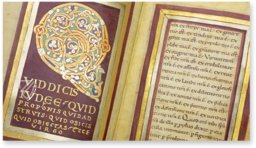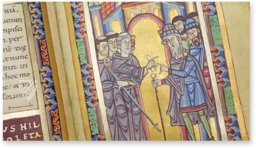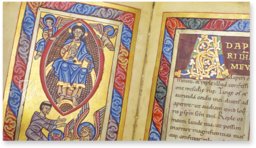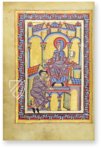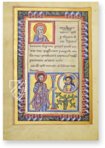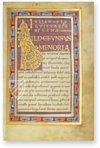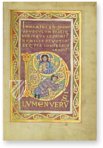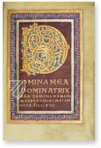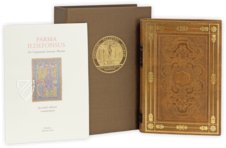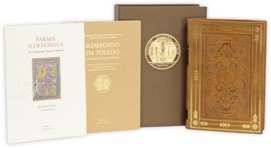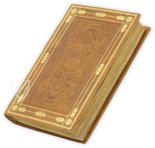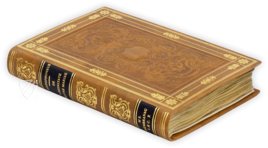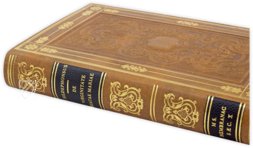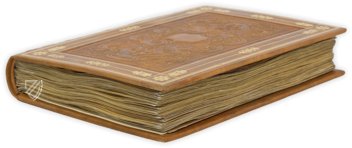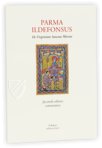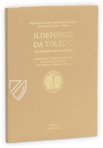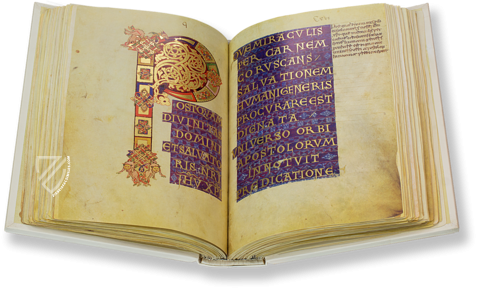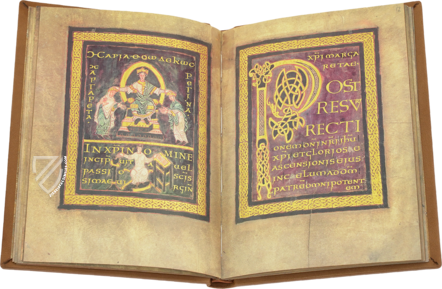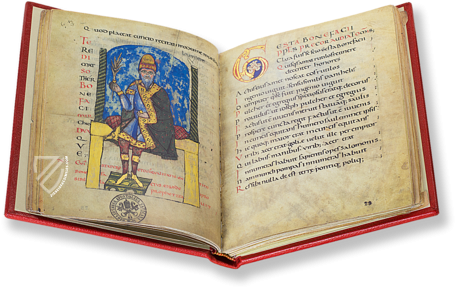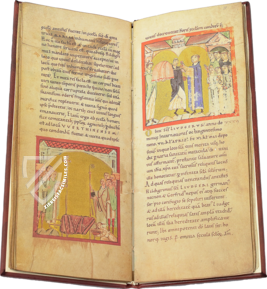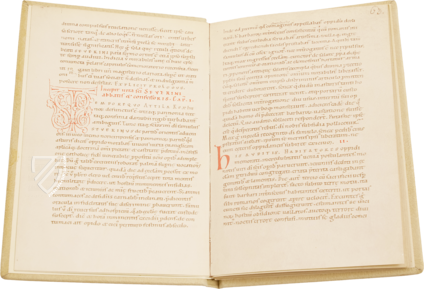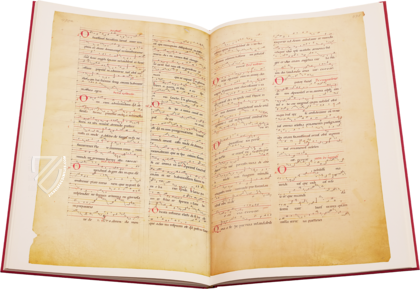Parma Ildefonsus
(3,000€ - 7,000€)
The Parma Ildefonsus was written between 1090 and 1110 in the French abbey of Cluny. This magnificently illuminated work in praise of the Holy Mother of God, strongly associated with the Spanish Reconquista, is the only surviving copy of the De Virginitate Sanctae Mariae of Saint Ildefons (607-667), Bishop of Toledo. It contains stunningly beautiful illustrations that are among the most magnificent portraits of Byzantine Romanesque book art. Each page of the work is richly decorated with gold, silver and purple. In addition to the numerous initials, some of them historiated, there are 33 splendid miniatures, including nine full-page illustrations.
Parma Ildefonsus
The abbey of the French city of Cluny produced an outstanding illuminated manuscript between 1090 and 1110. It is a codex known worldwide today by the title Parma Ildefonsus. The religious text was written as a doxology to the Virgin Mary and is a copy of the treatise De Virginitate Sanctae Mariae, which was composed by Saint Ildefonsus of Toldeo (ca. 607–667). The manuscript is wonderfully illustrated with nine large, full-page miniatures, 16 half-page miniatures, and 8 small, square miniatures. Additionally, the work is decorated by numerous initials, some historiated and some gilded.
The Reconquista of the Iberian Peninsula.
Toledo was the capital of the Visigothic Kingdom from ca. 531 to 711. In the year 712, the city was conquered by the Moors and under Islamic rule, particularly during the Caliphate of Cordoba, it truly flourished. On the 25th of May, 1085, the city was reconquered by Alfonso VI in the course of the Reconquista. Archbishop Bernard of Toledo was to be the Primate of the Catholic Church on the Iberian Peninsula from then on. It is assumed that the treatise De Virginitate Sanctae Mariae was composed for the Archbishop. That manuscript was written shortly after the Catholic recapture of the city and it has been closely associated with this event as a result. Parma Ildefonsus is the only copy of the treatise that exactly reproduces its original text. Additionally, it is the only copy worldwide attended by such phenomenal book decoration.
A Complex System of Illustration
The pages of the Parma Ildefonsus are illustrated in a unique, complex manner. All of the pictures as well as the text of the codex are rimmed by frames of gold, silver, and purple, which are patterned in the most various ways. Some of the frames demonstrate geometric forms, others stylish plant motifs. The large and small miniatures, in which saints and prophets are illustrated, boast splendid colors and doubtlessly belong among the highest-quality images of Byzantine-Romanesque illumination. Many large initials were set against a purple background and are also framed by various patterns. A particularly large and elaborately embellished initial shows the author of the manuscript as he presents his work kneeling before Christ.
Codicology
- Alternative Titles
- Ildefonso da Toledo
Parma Ildefonso
Ildefonso Toletano
De virginitate Beatae Mariae
De virginitate Sanctae Mariae - Size / Format
- 224 pages / 23.0 × 15.8 cm
- Origin
- France
- Date
- Between 1090 and 1100
- Epochs
- Style
- Language
- Script
- Carolingian minuscule
- Illustrations
- 9 pages fully illuminated; 16 half page miniatures, 10 portraits of the prophets, 9 large initials, 28 initials and many other decorations. Every text page features a beautiful border.
- Content
- Life of St. Ildefonsus by Julian of Toledo; De Virginitate Sanctae Mariae by St. Ildefonsus of Toledo; Prologue by the scribe Gomez addressed to Bishop Godescalc of Le Puy; Life of St. Ildefonsus by Bishop Sixila of Toledo
- Artist / School
- Colophon Painter
- Previous Owners
- Bernardo de la Sauvetat (ca. 1050 – 1125) formerly a monk in Cluny and later Bishop of Toledo
Paolo Maria Piciaudi (1710–85)
Matteo Luigi Canonici (1727–1805)
Parma Ildefonsus
Historiated “D” Initial
St. Ildefonsus kneels humbly below a Byzantine-style image of Christ Pantocrator or Christ in Majesty, his humble tonsure contrasting with Christ’s flowing hair. This fine specimen is indicative of both the trend toward elaborate initials in Romanesque manuscripts and the refinement of the art produced in the scriptorium of France’s Cluny Abbey, which was the intellectual center of Europe at the time. Its green-and-gold color scheme contrasts wonderfully with the purple background.
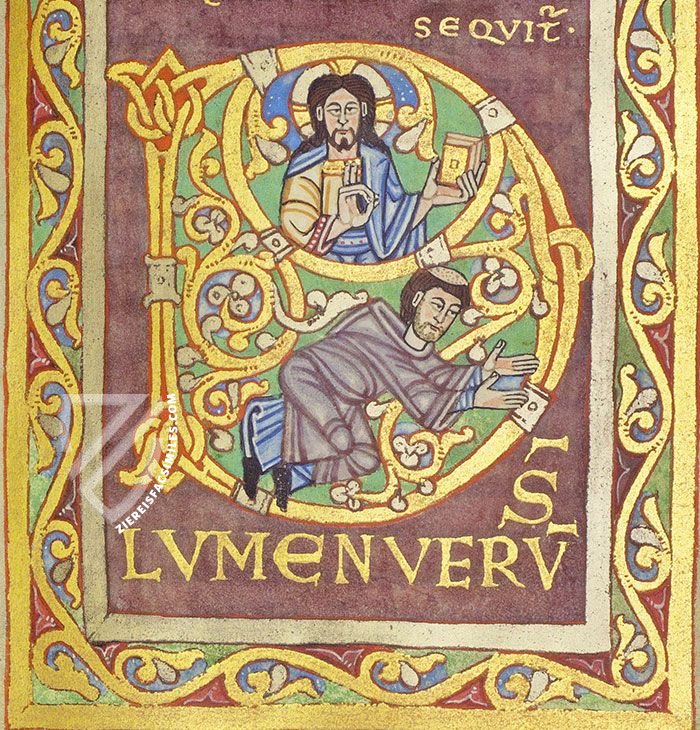
Parma Ildefonsus
Author Portrait
St. Ildefonsus was a scholar and theologian living during the 7th century in Toledo, which was the capital of the Visigothic Kingdom. He wrote the treatise at hand for his employer, the Archbishop of Toledo. This Romanesque miniature depicting him exhibits strong influences from Byzantine illumination, especially with respect to the standardized faces and burnished gold background.
Identified by his Gothic name, Hildefuns, St. Ildefonsus is pictured seated on a throne of red, blue, and gold with quill and tablet in hand. He is surrounded by other tonsured monks, some of them bearded, some of them fresh-faced acolytes. The scene is depicted within a bright frame of golden tendrils and features an abstract classical architecture.
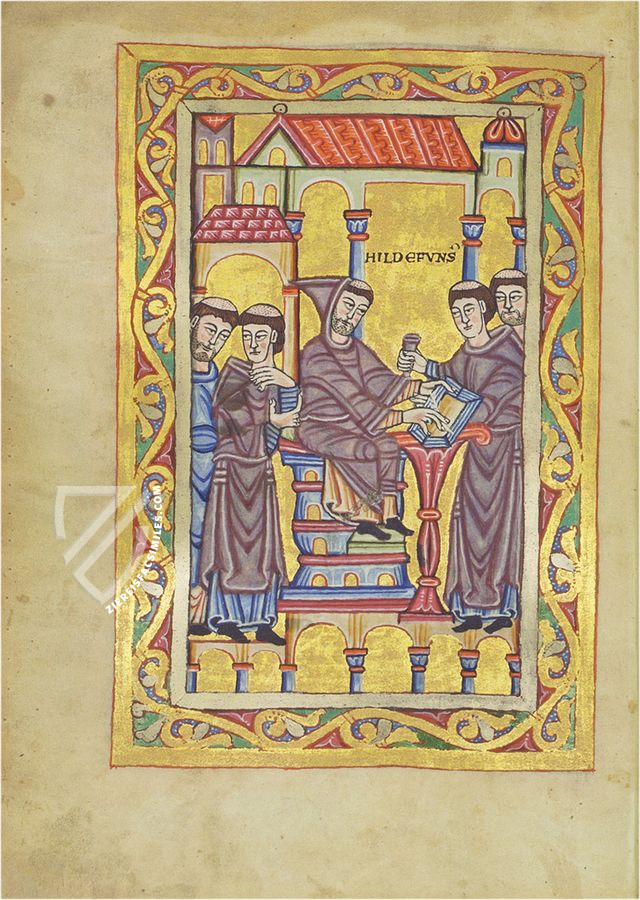
#1 Ildefonso Toletano
Languages: Italian, English
(3,000€ - 7,000€)
- Treatises / Secular Books
- Apocalypses / Beatus
- Astronomy / Astrology
- Bestiaries
- Bibles / Gospels
- Chronicles / History / Law
- Geography / Maps
- Saints' Lives
- Islam / Oriental
- Judaism / Hebrew
- Single Leaf Collections
- Leonardo da Vinci
- Literature / Poetry
- Liturgical Manuscripts
- Medicine / Botany / Alchemy
- Music
- Mythology / Prophecies
- Psalters
- Other Religious Books
- Games / Hunting
- Private Devotion Books
- Other Genres
- Afghanistan
- Armenia
- Austria
- Belgium
- Belize
- Bosnia and Herzegovina
- China
- Colombia
- Costa Rica
- Croatia
- Cyprus
- Czech Republic
- Denmark
- Egypt
- El Salvador
- Ethiopia
- France
- Germany
- Greece
- Guatemala
- Honduras
- Hungary
- India
- Iran
- Iraq
- Israel
- Italy
- Japan
- Jordan
- Kazakhstan
- Kyrgyzstan
- Lebanon
- Liechtenstein
- Luxembourg
- Mexico
- Morocco
- Netherlands
- Palestine
- Panama
- Peru
- Poland
- Portugal
- Romania
- Russia
- Serbia
- Spain
- Sri Lanka
- Sweden
- Switzerland
- Syria
- Tajikistan
- Turkey
- Turkmenistan
- Ukraine
- United Kingdom
- United States
- Uzbekistan
- Vatican City
- A. Oosthoek, van Holkema & Warendorf
- Aboca Museum
- Ajuntament de Valencia
- Akademie Verlag
- Akademische Druck- u. Verlagsanstalt (ADEVA)
- Aldo Ausilio Editore - Bottega d’Erasmo
- Alecto Historical Editions
- Alkuin Verlag
- Almqvist & Wiksell
- Amilcare Pizzi
- Andreas & Andreas Verlagsbuchhandlung
- Archa 90
- Archiv Verlag
- Archivi Edizioni
- Arnold Verlag
- ARS
- Ars Magna
- ArtCodex
- AyN Ediciones
- Azimuth Editions
- Badenia Verlag
- Bärenreiter-Verlag
- Belser Verlag
- Belser Verlag / WK Wertkontor
- Benziger Verlag
- Bernardinum Wydawnictwo
- BiblioGemma
- Biblioteca Apostolica Vaticana (Vaticanstadt, Vaticanstadt)
- Bibliotheca Palatina Faksimile Verlag
- Bibliotheca Rara
- Boydell & Brewer
- Bramante Edizioni
- Bredius Genootschap
- Brepols Publishers
- British Library
- C. Weckesser
- Caixa Catalunya
- Canesi
- CAPSA, Ars Scriptoria
- Caratzas Brothers, Publishers
- Carus Verlag
- Casamassima Libri
- Centrum Cartographie Verlag GmbH
- Chavane Verlag
- Christian Brandstätter Verlag
- Circulo Cientifico
- Club Bibliófilo Versol
- Club du Livre
- CM Editores
- Collegium Graphicum
- Collezione Apocrifa Da Vinci
- Comissão Nacional para as Comemorações dos Descobrimentos Portugueses
- Coron Verlag
- Corvina
- CTHS
- D. S. Brewer
- Damon
- De Agostini/UTET
- De Nederlandsche Boekhandel
- De Schutter
- Deuschle & Stemmle
- Deutscher Verlag für Kunstwissenschaft
- DIAMM
- Droz
- E. Schreiber Graphische Kunstanstalten
- Ediciones Boreal
- Ediciones Grial
- Ediclube
- Edições Inapa
- Edilan
- Editalia
- Edition Deuschle
- Edition Georg Popp
- Edition Leipzig
- Edition Libri Illustri
- Editiones Reales Sitios S. L.
- Éditions de l'Oiseau Lyre
- Editions Medicina Rara
- Editorial Casariego
- Editorial Mintzoa
- Editrice Antenore
- Editrice Velar
- Edizioni Edison
- Egeria, S.L.
- Eikon Editores
- Electa
- Emery Walker Limited
- Enciclopèdia Catalana
- Eos-Verlag
- Ephesus Publishing
- Ernst Battenberg
- Eugrammia Press
- Extraordinary Editions
- Fackelverlag
- Facsimila Art & Edition
- Facsimile Editions Ltd.
- Facsimilia Art & Edition Ebert KG
- Faksimile Verlag
- Feuermann Verlag
- Folger Shakespeare Library
- Franco Cosimo Panini Editore
- Friedrich Wittig Verlag
- Fundación Hullera Vasco-Leonesa
- G. Braziller
- Gabriele Mazzotta Editore
- Gebr. Mann Verlag
- Gesellschaft für graphische Industrie
- Getty Research Institute
- Giovanni Domenico de Rossi
- Giunti Editore
- Graffiti
- Grafica European Center of Fine Arts
- Guido Pressler
- Guillermo Blazquez
- Gustav Kiepenheuer
- H. N. Abrams
- Harrassowitz
- Harvard University Press
- Helikon
- Hendrickson Publishers
- Henning Oppermann
- Herder Verlag
- Hes & De Graaf Publishers
- Hoepli
- Holbein-Verlag
- Houghton Library
- Hugo Schmidt Verlag
- Idion Verlag
- Il Bulino, edizioni d'arte
- ILte
- Imago
- Insel Verlag
- Insel-Verlag Anton Kippenberger
- Instituto de Estudios Altoaragoneses
- Instituto Nacional de Antropología e Historia
- Introligatornia Budnik Jerzy
- Istituto dell'Enciclopedia Italiana - Treccani
- Istituto Ellenico di Studi Bizantini e Postbizantini
- Istituto Geografico De Agostini
- Istituto Poligrafico e Zecca dello Stato
- Italarte Art Establishments
- Jan Thorbecke Verlag
- Johnson Reprint Corporation
- Josef Stocker
- Josef Stocker-Schmid
- Jugoslavija
- Karl W. Hiersemann
- Kasper Straube
- Kaydeda Ediciones
- Kindler Verlag / Coron Verlag
- Kodansha International Ltd.
- Konrad Kölbl Verlag
- Kurt Wolff Verlag
- La Liberia dello Stato
- La Linea Editrice
- La Meta Editore
- Lambert Schneider
- Landeskreditbank Baden-Württemberg
- Leo S. Olschki
- Les Incunables
- Liber Artis
- Library of Congress
- Libreria Musicale Italiana
- Lichtdruck
- Lito Immagine Editore
- Lumen Artis
- Lund Humphries
- M. Moleiro Editor
- Maison des Sciences de l'homme et de la société de Poitiers
- Manuscriptum
- Martinus Nijhoff
- Maruzen-Yushodo Co. Ltd.
- MASA
- Massada Publishers
- McGraw-Hill
- Metropolitan Museum of Art
- Militos
- Millennium Liber
- Müller & Schindler
- Nahar - Stavit
- Nahar and Steimatzky
- National Library of Wales
- Neri Pozza
- Nova Charta
- Oceanum Verlag
- Odeon
- Orbis Mediaevalis
- Orbis Pictus
- Österreichische Staatsdruckerei
- Oxford University Press
- Pageant Books
- Parzellers Buchverlag
- Patrimonio Ediciones
- Pattloch Verlag
- PIAF
- Pieper Verlag
- Plon-Nourrit et cie
- Poligrafiche Bolis
- Presses Universitaires de Strasbourg
- Prestel Verlag
- Princeton University Press
- Prisma Verlag
- Priuli & Verlucca, editori
- Pro Sport Verlag
- Propyläen Verlag
- Pytheas Books
- Quaternio Verlag Luzern
- Reales Sitios
- Recht-Verlag
- Reichert Verlag
- Reichsdruckerei
- Reprint Verlag
- Riehn & Reusch
- Roberto Vattori Editore
- Rosenkilde and Bagger
- Roxburghe Club
- Salerno Editrice
- Saltellus Press
- Sandoz
- Sarajevo Svjetlost
- Schöck ArtPrint Kft.
- Schulsinger Brothers
- Scolar Press
- Scrinium
- Scripta Maneant
- Scriptorium
- Shazar
- Siloé, arte y bibliofilia
- SISMEL - Edizioni del Galluzzo
- Sociedad Mexicana de Antropología
- Société des Bibliophiles & Iconophiles de Belgique
- Soncin Publishing
- Sorli Ediciones
- Stainer and Bell
- Studer
- Styria Verlag
- Sumptibus Pragopress
- Szegedi Tudomànyegyetem
- Taberna Libraria
- Tarshish Books
- Taschen
- Tempus Libri
- Testimonio Compañía Editorial
- Thames and Hudson
- The Clear Vue Publishing Partnership Limited
- The Facsimile Codex
- The Folio Society
- The Marquess of Normanby
- The Richard III and Yorkist History Trust
- Tip.Le.Co
- TouchArt
- TREC Publishing House
- TRI Publishing Co.
- Trident Editore
- Tuliba Collection
- Typis Regiae Officinae Polygraphicae
- Union Verlag Berlin
- Universidad de Granada
- University of California Press
- University of Chicago Press
- Urs Graf
- Vallecchi
- Van Wijnen
- VCH, Acta Humaniora
- VDI Verlag
- VEB Deutscher Verlag für Musik
- Verlag Anton Pustet / Andreas Verlag
- Verlag Bibliophile Drucke Josef Stocker
- Verlag der Münchner Drucke
- Verlag für Regionalgeschichte
- Verlag Styria
- Vicent Garcia Editores
- W. Turnowski Ltd.
- W. Turnowsky
- Waanders Printers
- Wiener Mechitharisten-Congregation (Wien, Österreich)
- Wissenschaftliche Buchgesellschaft
- Wissenschaftliche Verlagsgesellschaft
- Wydawnictwo Dolnoslaskie
- Xuntanza Editorial
- Zakład Narodowy
- Zollikofer AG

